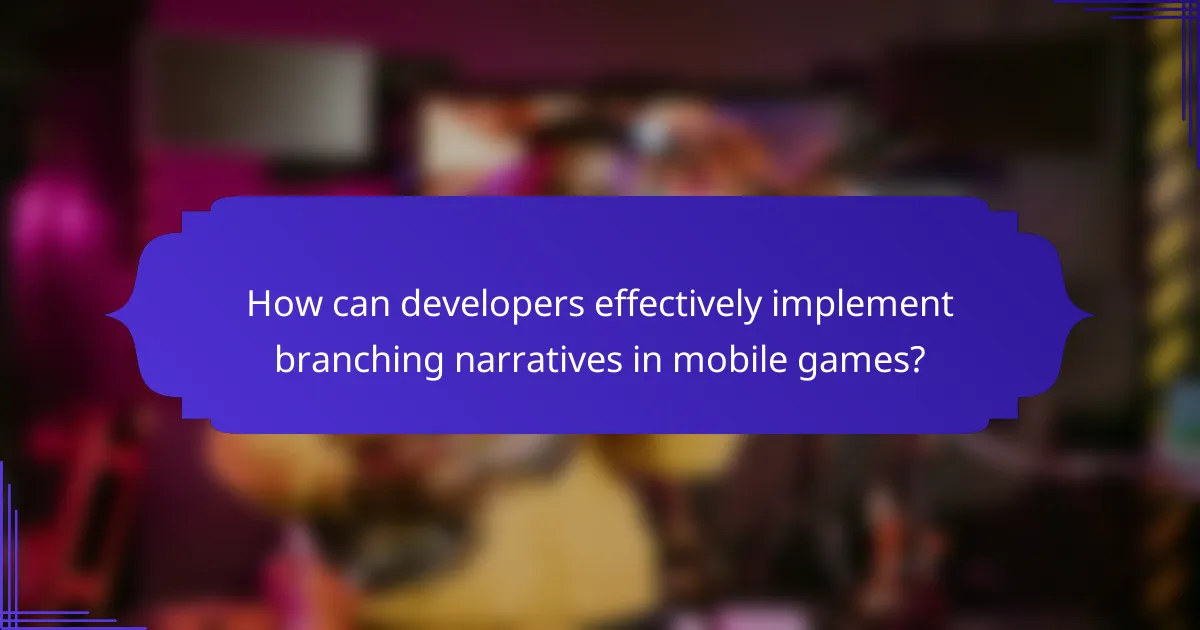Branching narratives in mobile games enhance player engagement by allowing choices that shape story outcomes. This article explores the benefits of these narratives, effective implementation strategies, challenges developers face, successful game examples, and emerging trends like AI-driven personalisation and community-driven content. Understanding these aspects can help developers create more immersive and impactful gaming experiences.

What are the key characteristics of branching narratives in mobile games?
Branching narratives in mobile games are characterised by player choice, multiple outcomes, and immersive storytelling. These narratives enhance engagement by allowing players to influence the story, creating personalised experiences. Key characteristics include dynamic plotlines that adapt based on decisions, character development reflecting player actions, and replayability due to varied endings. Additionally, branching narratives often incorporate unique attributes such as emotional impact and player agency, making them a compelling feature in mobile gaming.
How do branching narratives enhance player engagement?
Branching narratives significantly enhance player engagement by offering personalised experiences. Players feel a stronger connection to the story as their choices shape outcomes. This interactivity increases immersion, making players more invested in the game. Additionally, branching narratives can lead to higher replayability, encouraging players to explore different paths and endings.
What are common forms of branching narratives in mobile games?
Common forms of branching narratives in mobile games include choice-based dialogues, multiple endings, character-driven paths, and quest branching. These formats enhance player engagement by offering personalised experiences and replayability. Choice-based dialogues allow players to select responses that impact story outcomes. Multiple endings provide diverse resolutions based on player decisions, creating a unique narrative experience. Character-driven paths focus on individual character arcs, influencing the main storyline. Quest branching enables players to choose different objectives, leading to varied gameplay experiences.

What benefits do branching narratives provide to game developers?
Branching narratives enhance creativity and player engagement for game developers. They provide opportunities for deeper storytelling, allowing players to make choices that affect outcomes. This interactivity fosters emotional investment, leading to increased player retention. Additionally, branching narratives can differentiate games in a competitive market, attracting diverse audiences.
How do branching narratives impact storytelling and player choice?
Branching narratives enhance storytelling by allowing players to make meaningful choices that influence outcomes. They foster engagement and replayability in mobile games. Players experience unique paths, creating personal connections to the story. This approach can lead to diverse character development and emotional investment. Implementing branching narratives requires careful planning to balance player agency with coherent storytelling.
What are the potential revenue implications of implementing branching narratives?
Implementing branching narratives can significantly enhance revenue by increasing player engagement and retention. These narratives create personalised experiences, encouraging players to invest more time and money.
1. Increased player retention: Players are more likely to return when their choices affect the storyline.
2. Higher in-game purchases: Engaging narratives can lead to more spending on character upgrades and story expansions.
3. Enhanced word-of-mouth marketing: Satisfied players often share their experiences, attracting new users.
4. Potential for premium content: Developers can offer paid storylines or exclusive branching paths, generating additional revenue streams.
Overall, branching narratives foster deeper player connections, leading to greater financial success in mobile games.

How can developers effectively implement branching narratives in mobile games?
Developers can effectively implement branching narratives in mobile games by focusing on player choice and story depth. First, create a flexible story structure that accommodates multiple outcomes based on player decisions. This enhances engagement and replayability. Second, utilise player feedback to refine narrative paths, ensuring they resonate with the audience. Third, integrate visual and audio cues to enhance the storytelling experience, making choices feel impactful. Lastly, test various narrative branches to maintain balance and coherence, ensuring each path is rewarding.
What tools and technologies are available for creating branching narratives?
Various tools and technologies enable the creation of branching narratives in mobile games. Popular options include Twine, Ink, and Unity. Twine offers a user-friendly interface for nonlinear storytelling, while Ink provides a scripting language for more complex narratives. Unity supports advanced game development with branching story capabilities through its visual scripting tools. Additionally, tools like Articy Draft help in planning and managing narrative structures effectively.
How can narrative design influence player retention?
Branching narratives significantly enhance player retention by fostering emotional investment and personalised experiences. Players are more likely to remain engaged when their choices impact the game’s outcome. This approach creates a sense of agency, encouraging exploration and replayability. Furthermore, well-crafted branching narratives can deepen character development, making players feel more connected to the story. Implementing these narratives requires careful planning and a robust understanding of player motivations to ensure that choices resonate meaningfully within the game world.
What are the best practices for testing branching narrative paths?
To effectively test branching narrative paths, employ iterative playtesting with diverse player feedback. Focus on identifying decision impact, ensuring narrative coherence, and optimising player engagement. Use analytics to track choices and outcomes, refining paths based on player behaviour.

Which challenges do developers face when creating branching narratives?
Developers face several challenges when creating branching narratives, including complexity in story design, player engagement, and resource allocation. Designing multiple story paths requires intricate planning to ensure coherence and meaningful choices. Player engagement can wane if narratives lack depth or fail to resonate with the audience. Additionally, managing resources effectively is crucial, as extensive branching can lead to increased development time and costs. Balancing these factors is essential for successful implementation in mobile games.
How can narrative complexity affect game performance?
Narrative complexity enhances game performance by creating immersive experiences that engage players. Branching narratives allow for diverse player choices, leading to increased replayability and emotional investment. This complexity can improve player satisfaction and retention rates in mobile games. Implementing branching narratives requires careful planning to ensure coherent storylines and meaningful choices that resonate with players.
What are common pitfalls to avoid in branching narrative design?
Common pitfalls in branching narrative design include lack of coherence, overcomplicating choices, neglecting player agency, and failing to test narratives. Coherence ensures that all narrative branches align with the central theme. Overcomplicating choices can confuse players, diminishing engagement. Prioritising player agency allows for meaningful decision-making, enhancing immersion. Lastly, thorough testing helps identify narrative flaws, ensuring a smooth experience.

What are some successful examples of branching narratives in mobile games?
Successful examples of branching narratives in mobile games include “Life is Strange,” “The Walking Dead,” and “Choices.” These games allow players to make choices that impact the story’s direction, creating unique experiences. “Life is Strange” features time manipulation, enhancing narrative depth. “The Walking Dead” emphasises emotional decisions, affecting character relationships. “Choices” offers varied genres, showcasing different narrative styles. Each game demonstrates the benefits of player agency and engagement through branching storylines.
How do cultural differences influence the reception of branching narratives?
Cultural differences significantly shape how branching narratives are received in mobile games. These narratives often reflect cultural values, social norms, and storytelling traditions unique to different societies.
For instance, players from collectivist cultures may prefer narratives emphasising community and relationships, while those from individualist cultures might favour personal achievement and autonomy. The design and choices within branching narratives can either resonate with or alienate players based on these cultural contexts.
Moreover, localisation strategies can enhance reception by adapting narratives to align with cultural expectations. This ensures that character motivations, plot developments, and moral dilemmas are relatable, thus improving player engagement and satisfaction. Understanding these cultural nuances is crucial for developers aiming to create impactful branching narratives in mobile games.
What lessons can be learned from popular mobile games featuring branching narratives?
Popular mobile games with branching narratives teach valuable lessons about player engagement and storytelling. These games emphasise the importance of player choices, enhancing emotional investment and replayability.
One key lesson is the significance of meaningful consequences. Players are more likely to stay engaged when decisions lead to distinct outcomes, creating a sense of agency. Additionally, integrating diverse character arcs enriches the narrative experience, allowing players to explore different perspectives.
Another important aspect is pacing. Well-structured branching paths maintain a balance between tension and resolution, keeping players invested. Games that offer a variety of endings also encourage exploration, rewarding players for their curiosity.
Lastly, feedback mechanisms play a critical role. Providing players with clear responses to their choices fosters a deeper connection to the narrative, making them feel their decisions truly matter.

What future trends are emerging in branching narratives for mobile games?
Emerging trends in branching narratives for mobile games focus on player agency, personalised storytelling, and advanced technology integration. These trends enhance user engagement and create immersive experiences.
1. Enhanced Player Agency: Games increasingly allow players to make impactful choices that shape the storyline, fostering deeper emotional connections.
2. AI-Driven Personalisation: Artificial intelligence tailors narratives based on player behaviour, preferences, and past decisions, offering unique experiences for each player.
3. Cross-Platform Storytelling: Mobile games are integrating narratives that span multiple devices, ensuring continuity and engagement across platforms.
4. Dynamic Storylines: Developers are implementing real-time adjustments to narratives based on player actions, creating a more responsive gaming environment.
5. Community-Driven Content: Players contribute to narrative development through feedback and user-generated content, enriching the storytelling landscape.
6. Virtual and Augmented Reality: These technologies are being utilised to create immersive branching narratives that enhance the overall gaming experience.
How might advancements in technology shape branching narratives?
Advancements in technology will enhance branching narratives by enabling more complex decision-making and personalised experiences. Technologies like artificial intelligence and machine learning allow for adaptive storylines that respond to player choices in real-time. This creates a more immersive environment, engaging players on a deeper emotional level. Additionally, virtual reality can transform how narratives are experienced, making interactions feel more tangible and impactful. As a result, mobile games will likely evolve to offer richer, more varied storytelling experiences that cater to individual player preferences.
What role will player feedback play in the evolution of branching narratives?
Player feedback is crucial for evolving branching narratives as it shapes player experience and engagement. Feedback allows developers to understand player preferences, identify narrative strengths and weaknesses, and adapt storylines accordingly. This iterative process enhances the narrative depth and ensures alignment with player expectations, ultimately leading to a more immersive gaming experience. Engaging players in this way can result in unique narrative paths, reflecting their choices and enhancing replayability.
What strategies can developers adopt to stay ahead in the narrative gaming landscape?
Developers can adopt adaptive storytelling, player choice integration, and data-driven narrative design to stay ahead in the narrative gaming landscape. These strategies enhance engagement and personalise player experiences.
Adaptive storytelling allows narratives to evolve based on player decisions, creating a unique journey. Integrating player choices fosters emotional investment, making players feel their decisions impact the game. Data-driven narrative design utilises player feedback and analytics to refine story elements, ensuring relevance and resonance.
By focusing on these strategies, developers can create compelling, immersive experiences that captivate audiences and stand out in a competitive market.
